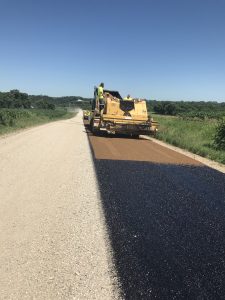Otta Seal Surfacing Workshop
Description
- Iowa has over 71,000 miles of unpaved secondary roads carrying very low daily traffic volumes but frequently supporting heavy vehicle (i.e., farm equipment) movements and Iowa’s county road departments spend over $110 million annually for maintaining gravel road surface.
- Otta seals are a thin bituminous surface treatment (BST) of graded aggregate that can range from natural gravel to crushed stone with a low viscosity binder.
- Essentially a 0.6 to 1.2 inch (16 to 32 mm) thick bituminous surfacing admixture of graded aggregates in combination with relatively soft binders with or without a sand seal cover.
- The binder works its way upwards through the aggregate interstices.
- Dense, durable matrix that relies on both “mechanical interlock” and “bitumen binding” to carry traffic loads.
- It can be constructed using more economical, local aggregates and utilizing regularly available equipment (asphalt distributor, aggregate spreader, pneumatic-tired roller, and mechanical broom) that is often used for asphalt maintenance.
Event Speakers
Charles Øverby
Mr. Charles Øverby is a retired Chief Roads Engineer at the Norwegian Public Roads Administration (NPRA), Operational Technology Department, International Division, a position he held from 1984 – 2017. From 1977 – 1981, he was working with Roads Department, Botswana at the Rural Roads Division as a Materials and Pavement Engineer. During the last twenty years he has basically been operating on the African continent commissioned to give technical assistance to road and road-related projects financed by the Norwegian Agency for Development Cooperation (NORAD). He has also been providing consultancy services to various consultant companies and the World Bank. He has been working in the following countries outside Scandinavia: Botswana, Kenya, Sudan, Zambia, Tanzania, Mauritius and Bangladesh. Mr. Charles Øverby has presented several papers at international conferences, especially on the topic of low-volume sealed roads. He is the author of the NPRA Guideline, “A Guide to the Use of Otta Seals”, an extensively cited and foundational reference document on Otta seal.
Halil Ceylan
Dr. Halil Ceylan is a professor in the Department of Civil, Construction and Environmental Engineering and the director of the Program for Sustainable Pavement Engineering and Research at Iowa State University. He has extensive experience in roadway/pavement analysis, design, performance, and materials evaluation. He has been involved with over 95 research projects serving as the PI and/or Co-PI—all related to transportation infrastructure systems, and sponsored by the Federal Aviation Administration, the Federal Highway Administration, the Iowa Department of Transportation, the National Cooperative Highway Research Program, the second Strategic Highway Research Program (SHRP2), and several other funding agencies. Dr. Ceylan has also authored or co-authored over 250 publications including 6 edited books, 3 invited book chapters, over 100 journal articles (plus three fully peer-reviewed Geotechnical Special Publications), over 160 fully refereed proceedings articles and technical reports, etc. He has also delivered over 300 technical presentations including over 100 invited lectures and presentations (at universities and technical conferences/meetings) with several keynote lectures. He has also served as a member of more than 25 national and international committees and organizations (including the TRB, ASCE, TERRA, USUCGER, ACI, ISCP, TASSA, ASEE, etc.) and organized and chaired many technical conference sessions for these professional associations.
Charles T. Jahren
Dr. Charles T. Jahren is a professor and the Associate Chair of the Department of Civil, Construction and Environmental Engineering at Iowa State University. He has had considerable experience with road maintenance and rehabilitation, especially in the area of light surface treatments. Dr. Jahren is leading a current related Minnesota Local Road Research Board (LRRB) research project entitled “Lightly Surface Roads; Stabilized Aggregate Applications,” which includes an investigation of low cost methods to surface unpaved roads (including Otta seals) and rehabilitate pavements that have reached the end of their service life. Full depth reclamation and CIR followed by chip seals and Otta seals are considered in this research. In addition, he has been selected as the apparent PI and is currently in final negotiations with the Minnesota LRRB on a project entitled “Alternate Design Methods to Renew Lightly Traveled Paved Roads.” This project will review the performance of roads that have been full depth reclaimed and cold in-place recycle and surfaced with seal coats or Otta seals. Similarly, Dr. Jahren has been selected by and is negotiating with the Minnesota LRRB on a project to investigate the performance of various mixtures of crushed rock or gravel road surfacing with RAP with the goal of providing better service results for unpaved roads.
Agenda
| Time | Event |
| 8:30 a.m. | Registration |
| 9:00 a.m. | Welcome / Introduction – Halil Ceylan |
| 9:10 a.m. | Presentation: Bituminous Surfacings for Low Volume Roads – An Overview (Charles Overby) |
| 10:15 a.m. | Break |
| 10:30 a.m. | Presentation: Otta Seal Design, Construction, and Performance in Iowa (Halil Ceylan) |
| 11:30 a.m. | Lunch – Served at the Workshop |
| 12:30 p.m. | Presentation: Quality Assurance during Construction of Otta Seal (Charles Overby) |
| 1:30 p.m. | Break |
| 1:45 p.m. | Presentation: Otta Seal Experience in Minnesota (Charles Jahren) |
| 2:30 p.m. | Open Discussion on Successful implementation of Otta Seal in Iowa |
| 3:00 p.m. | Adjourn |
Who Should Attend?
County engineers, field technicians and other interested staff; Iowa DOT engineers, and technicians, and other interested staff; Contractors, aggregate/recycled material manufacturers and suppliers
Questions?
Paul Albritton, Iowa LTAP, 515-294-1231, palbritt@iastate.edu.